|
I contacted Cilogear and ordered a hipbelt Apr-17-2023. I spoke to them Jun-20-2023 and I was told it would ship that week. I spoke to them Jul-25-2023 and was told it would ship that day. I spoke to them around Aug-03-2023 and was told it should arrive Aug-04-2023. It never arrived. I sent them some emails and called them several times. No emails were answered and they never answered their phone again. I have seem a few posts on Facebook from Cilogear. I don't know if the company is still in business. I don't know if you order gear that it will ever arrive. I think they make great gear, but you need a company to stand behind their gear.
As a point in contrast, I bought a very high quality sleeping bag on ebay that was made in 1995. It had an issue and needed to be repaired. Even though the company had moved twice since 1995, they still existed. They answered my email within a day or so. I shipped them the broken part, and in a few weeks I had the repaired/replaced part back.
I bought a used CiloGear V5 75 WorkSack, size medium. This review concentrates on the differences between the V5 and v3 pack. You should look at the CiloGear 75 V5 review for a full pack review.
This is a 75 liter pack which is designed for alpine climbing, which is somewhat different from a general purpose pack. It is designed to carry two ice tools (ice axes) as well as a pair of crampons. That isn't very unusual, as many packs have the same features. The way the ice tools and crampons are attached are of a superior design to other packs. The pack is generally of a streamlined design, with little sticking out. That is pretty important for a climbing pack, but not so important for general use. It's construction is a bit more complex than any other pack that I am familiar with, and it is made with more different materials than any pack that I am familiar with. It is more modular and configurable than any other pack that I know of. The quality of workmanship is first rate, and overall it is the best designed pack that I have ever seen. The pack was not complete when I bought it, so I bought a lid, new framesheet, Carbon Control Rod, and a new hipbelt from CiloGear to make the pack complete and somewhat updated.
The 75L differs from other CiloGear packs in several ways. The most notable is that is is larger and designed to carry heavier loads. It's framesheet is similar to other CiloGear packs however it also has a Carbon Control Rod (CCR) that augments the standard framesheet. The framesheet and Carbon Control Rod can be tensioned with the Transverse Stability Strap (TSS) which is unique to the 75L. There are also external wand/bottle pockets on the sides of the pack. There is also a zipper going across the lower section of the pack which can be used to access a sleeping bag or other stuff at the bottom of the pack. There is also a removable internal divider inside the pack which is just above the pack zipper. The way the hipbelt is tensioned to the pack is different on the 75L pack. The v5 pack belt has a dee clip on the hipbelt which a strap goes through. This creates a 2 to 1 pulley, allowing for more tension. It is called the Ratchet hipbelt. I bought my pack used, and there were no instructions for the CCR, TSS, or Ratchet hipbelt. In addition, there are no instructions on the CiloGear web site for the CCR, TSS or Ratchet hipbelt. The Ratchet hipbelt has been discontinued and the new hipbelt design is similar to the rest of the CiloGear hipbelts.
I also have a v3 75L pack. The v5 pack has some differences from the v3 pack. tabs on the sides of the pack to attach a sled (the tan loops). The v5 pack has a central dee-clip between the tool holders, which the v3 pack had 2 slip-locks. The v5 pack has two dee-clips below the zipper. The v5 pack has a central slip-lock above the crampon holder. The top of the pack is thicker than the bottom of the pack, so this is a very useful improvement. The v5 pack has two dee-clips on the bottom of the pack.
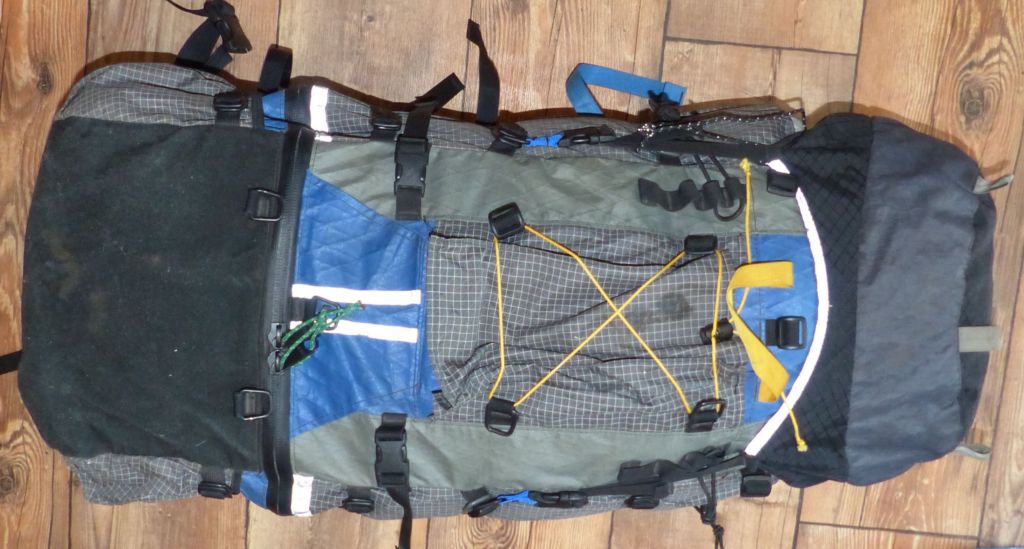
This is a view of the back of the pack. Many features of the pack are visible. The gray patch in the center is a pocket for holding crampons. I added the yellow cord to secure the pocket when not in use. I also patched two minor rips in it, which are visible as discolorations (I used seam grip on the outside and mcnett tenacious tape on the inside). The two blue triangle shaped pieces of material are where the heads of the ice tools go. The ice tool heads are secured with the side release buckles next to the red triangular material. The shaft of the ice tools are secured with the black cords that are higher up on the pack. The doubled cord is wrapped around the shaft, and then the cord is looped over the cord toggle. Then the cord toggle is tightened to secure the cord loop. The cord is heavy duty elastic cord, about 1/8 inch elastic. There is reflective material on the triangular ice tool flaps. The zipper has a urethane coating on the teeth to make it water-resistant. The v3 pack has a flap covering the zipper. Also there is a dee-clip between the ice tool holders and a slip-lock above the crampon holder, which is different than the v3 pack which had 2 slip-locks at the bottom of the tool holder. There are cords attached to the zipper pulls are visible.
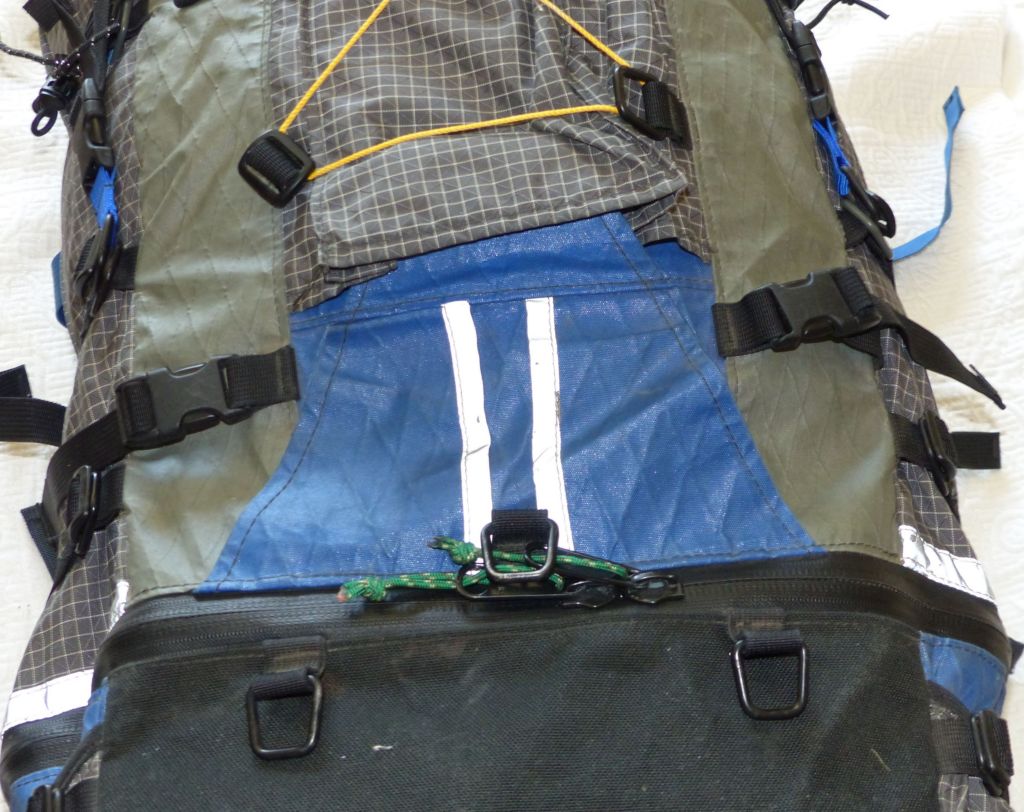
This is a close up of the tool holders on the pack. There is a flap of material sewn to the pack at both ends that secures the head of the tool. The shaft near the head is secured with the black side release buckle. The inside of the flap of material is edged with reflective material to make it easy to see in low light conditions. Under the flaps of material are sliplocks. Also visible is the crampon holder, made of gray Dyneema / Cordura ripstop fabric (which used to be called spectrum). Visible on the side of the crampon holder is a 'Dee-clip' which is what makes the pack so configurable. New for the v5 pack has a central lower dee-clip between the tool holders, and the two dee-clips below the zipper.
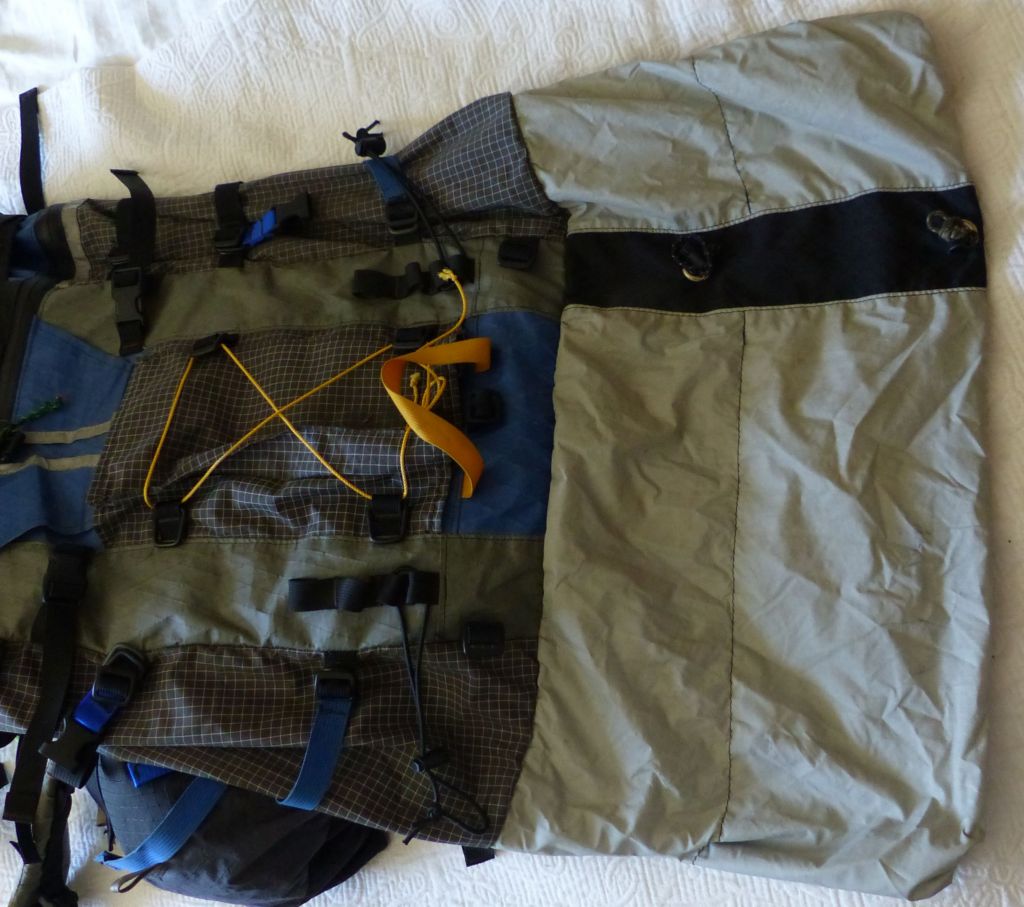
This picture shows the gray pack skirt extension. It is made of two layers of ripstop nylon coated with silicone, which is a very lightweight, and abrasion resistant. Since it is usually inside the pack, it doesn't need to be as robust as the normal exterior of the pack. You can see there are two draw-cords, one near the bottom of the skirt, which is the one that is usually used. They are Sterling Rope's Glo-Cord, which is 2.75mm cord with a reflective exterior. When the skirt is used, the drawcord on the top of the skirt is used. Also visible in this picture is the yellow haul strap on the back of the pack.
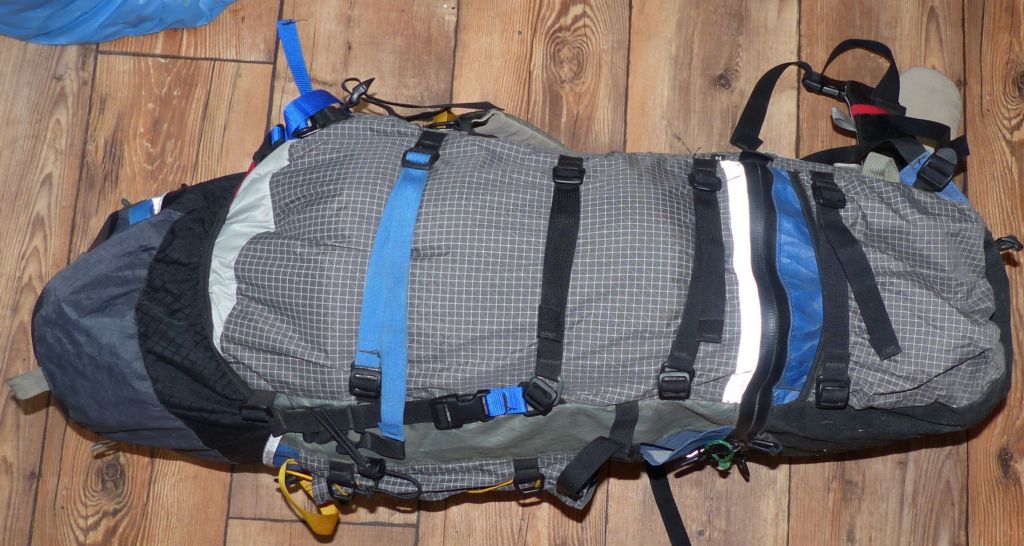
This is the side of the pack. The lid of the pack is on. Working down from the lid, are four compression straps. The bottom compression strap is over the external side pocket. The v5 pack has a better arrangement of sliplocks than the v3 pack. These straps are removable.You can arrange the straps at a diagonal. Included with the pack, but not shown are more straps release buckles, as well as longer straps. The owners manual describes some of the many possible options for using the straps. The zipper is visible right above the side pocket. New for the v5 pack is the side reflective strip. The bottom of the pack is made of Dimension Polyant VX51 which is 500x1000d Cordura nylon on the outside, and has a total of 5 plies of material. It is quite robust. The bottom of the side pocket has a grommet with a drainage hole at the bottom. The side pocket can hold a 64 oz bottle (2 liters) or snow wands and the like.
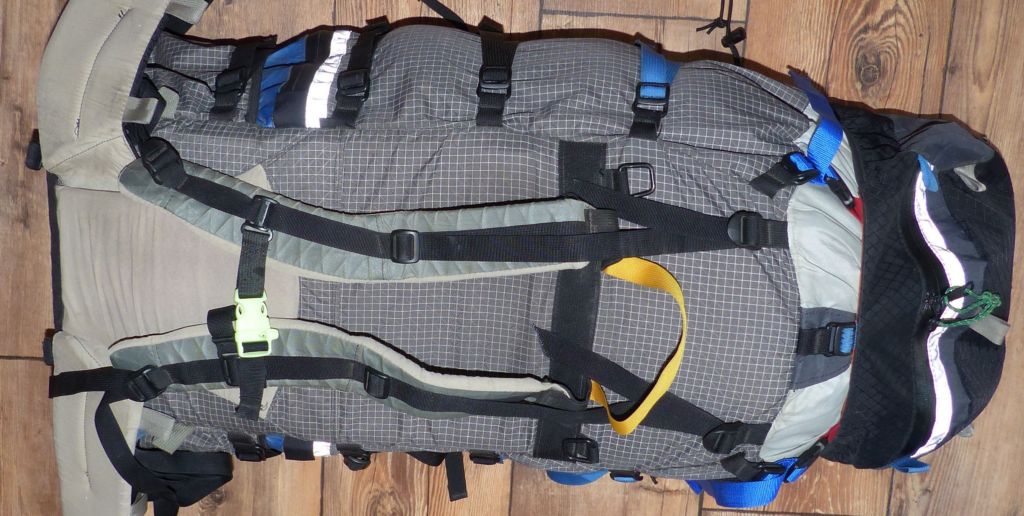
This is the front of the pack, i.e. the part which rests against your back. The lid is on the pack, and there is a reflective stripe of material next to the external lid zipper. The lid attaches to the pack with two adjustable blue straps, as well as a dee-clip in the center. If you use the skirt to load lots of stuff in the pack, the central dee-clip is disconnected and two higher dee-clips can be used to attach the lid, rather than the lower dee-clips. Next to the lid, is a yellow haul strap. Below that, is a piece of 1.5 inch wide black webbing. This is where the top of the shoulder straps attach to. The tops of the shoulder straps consist of two layers of 1.5 inch black webbing which is bartacked to the red material of the shoulder strap as well to the 1.5 inch wide black webbing on the pack. This makes a very strong flexible mounting point for the shoulder straps. Not visible, is the bottom of the shoulder straps which attach to a double thickness triangle of material which is the same material as the bottom of the pack. The shoulder straps have load transfer straps which attach to the top of the frame of the pack, and their attachment point on the shoulder strap is adjustable with the black slider visible on the shoulder straps. The pack was missing the sternum strap, so I fabricated one, using a glow in the dark side release buckle with a built in whistle. I like this more than the black and orange original sternum strap. The sternum strap adjusts up and down the shoulder pads. The shoulder straps are made with dense foam and a very hard outside layer.
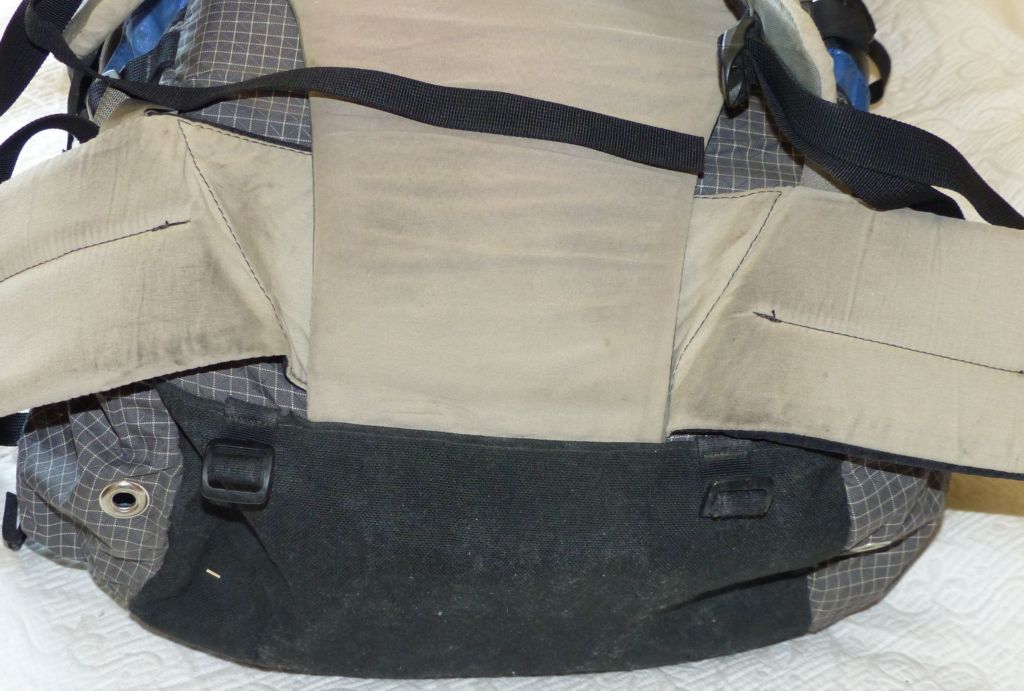
This is the bottom of the pack. New for the v5 pack are two dee clips. Perhaps they can be used to secure stuff below the pack. Also visible are the grommets at the bottom of the side pockets for water drainage. The lumbar pad is visible. The waist strap can adjust up or down via velcro on the strap and on the inside of the lumbar pad.

This is a close up of the tan sled loop. There is one on either side of the pack, right next to the shoulder strap attachment point (which is blue). The sled loop is used to attach a sled for hauling heavy loads. This is a new feature for the v5 pack. Also visible is the bottom slip-lock.
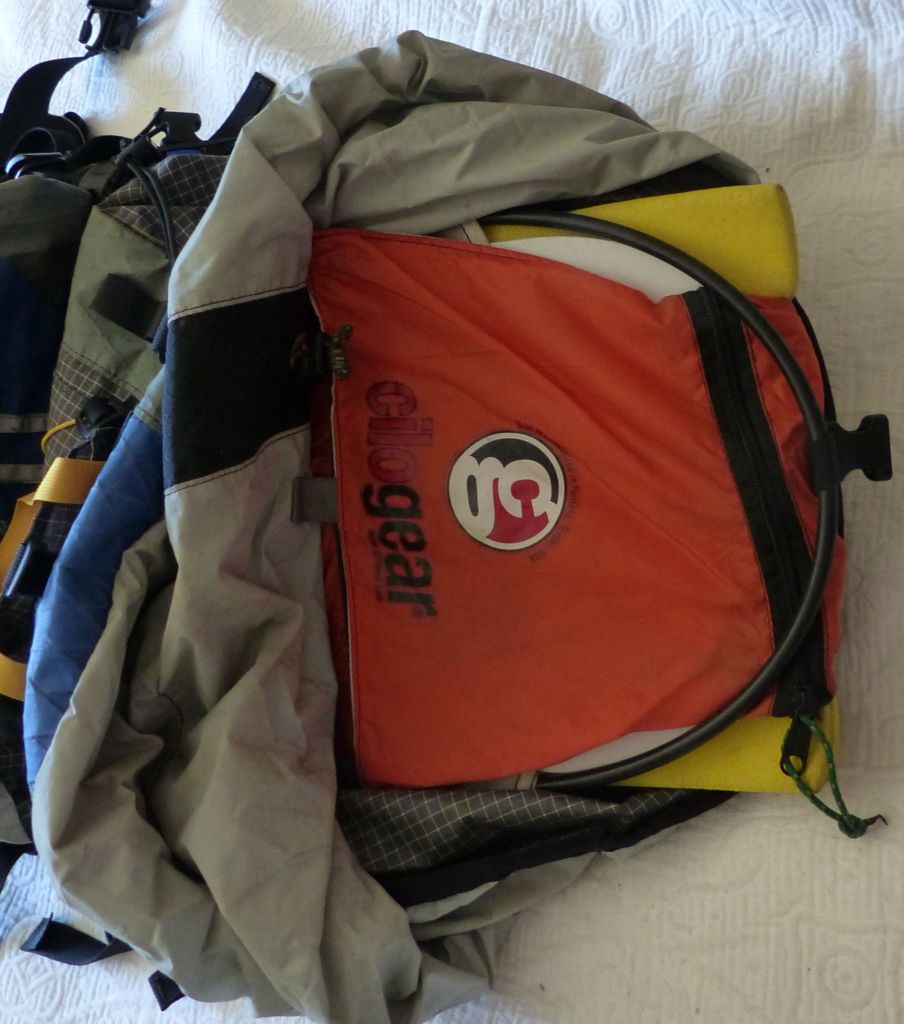 internal strap"/>
internal strap"/>
The foam, framesheet and CCR go inside a pocket inside the pack. The top of the frame pocket has a flap that folds over and velcros to secure the frame. On the flap is a orange zippered gear pocket. Not visible is the side tenoning strap right below the ninja pocket. Also not visible is the internal compression strap that clips to the clip above the ninja pocket. Also not visible is the large open pocket next to the framesheet, made out of silnylon. It is for a hydration bladder.
The pack is constructed with a wide variety of fabrics:
The pack comes with very little sewn onto it. There are many dee-clips, which are made out of steel and sliplocks (double D rings), which are made out of acetal, sewn onto the pack with webbing. You can attach a wide variety of straps on the pack to these dee-clips and sliplocks. You can compress the pack without the use of straps by mating the one or more pairs of the appropriate dee-clip and sliplock on the sides of the pack. I find that quite elegant. You can remove the lid as well as the hip belt. You can remove the foam padding as well as the framesheet (though it is unlikely I ever would). There are many places to strap things onto the pack, such as the six lash points on the top of the lid, and the gear loop attachment points on the hipbelt. You can use the extension skirt, and carry really bulky items, or use the pack as an emergency bivy and stick the lower half of your body inside of it.
One small detail I appreciate is that most of the straps are 0.75 inches wide. This is wide enough to not get twisted up, and plenty strong for virtually any use. My WildThings IceSac uses mostly heavy 1 inch webbing, which is overkill in my opinion.
If you have comments or suggestions, Email me at turbo-www@weasel.com
Created with gnu emacs and template-toolkit, not some sissy HTML editor.
No Java or javascript needed to view my web pages. They
both have significant security issues.